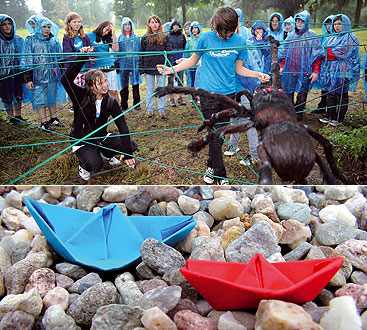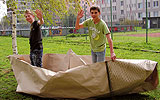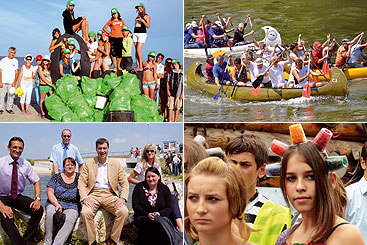Danube Day 2010: Getting active for the rivers!
ICPDR Danube Watch: 'Get active for the rivers!' was the call for Danube
Day 2010 and was a theme that people took ‘onboard’
and ran with! We danced, sang, canoed,
climbed, swam, cooked, explored and rapped
for the rivers. The river came to the street
and school went to the Danube. We
celebrated by being active and
by taking action.

Danube Day 2010: Getting active for the rivers!
“Get active for the rivers!” was the call for Danube Day 2010 and was a theme that people took ‘onboard’ and ran with! We danced, sang, canoed, climbed, swam, cooked, explored and rapped for the rivers. The river came to the street and school went to the Danube. We celebrated by being active and by taking action.

Danube Day activities allowed us to marvel at the spectacles and sights – such as Untangling the web in Austria’s Danube Challenge 2010 – and to involve ourselves in creating a sustainable future.
Danube Day 2010 was an immense success: despite the impacts of serious flooding in Danube countries, it continues to grow. Over 483 organisers – 60 more than last year – held 140 events. Actions built on previous years, cementing events in community life. They brought new partners, creating working relationships that will continue into the future. Overseen by the ICPDR, festivities stretched along the Danube and major tributaries, in 14 countries and 7 capitals. Romania beat all previous records: 205 organisations celebrated in over half the country’s counties. Bulgarians got active in 8 towns. In Serbia, 87 partners created a great tide of events in 16 locations. Sava Day, June 1st, marked the start in Serbia and, with events through to September, it’s been more a Danube Summer than a Danube Day.
Every sector of society was involved. From international canoe tours to Ukrainian-Romanian flag ceremonies, basin-wide and Danube-long art extravaganzas to Upper Tisza bilateral workshops, the day provided an impetus to bring people, communities and countries together. The devastating floods were a distressing reminder of the influence of rivers on our lives. Several events were cancelled; others focussed on flood issues: Czechs debated protection in Olomouc and warning systems were high on the agenda in Slovakia.
“The highlight of this year has been the cooperative efforts on both sides of the Tisza, working together to protect the river for future generations”, said Andriy Bublyk of Coca-Cola Beverages Ukraine. “This is perhaps a unique example of international cooperation which I hope will become a model for others”.

Children served as the best ambassadors, bringing the message of the Danube – literally – out into their communities, and proving that we are all in the same boat.
Getting active in the rivers. One topic stood
out above all others - getting active -
through sport and exercise or by helping
your community. Whichever
World Cup team you supported,
it was ‘Danube United’ all the
way in regional events: thousands
played football, enjoyed
fishing or had a laugh
in sack races. We waltzed
in Vienna, tangoed in
Belgrade, belly danced
in Adony and marched in
Lom. Ukraine’s Tisza has
Talent in the tiny village
of Dilove saw 350 people
cheer on their favourites -
including cycling acrobats in
Danube Day T-shirts!

People got in boats: from Serbs learning to sail to professionals wowing Hungarian crowds. But who needs boats: in Ingolstadt, 100 courageous people braved cold temperatures and high waters to swim a 1km stretch. A flagship event is Austria’s Danube Challenge, and 400 children won the chance to take part. Environment Minister Nicholas Berlakovich and swimming champion Mirna Jukic welcomed the youngsters who were faced with an extra challenge - torrential rain! They valiantly soldiered on: ponddipping, tracking, spider-web climbing and rapping.
Getting active for your community. People rolled up their sleeves and filled bin bags. Plastic pollution was a focus: Derventa NGO Forum from Bosnia-Herzegovina put it best with their Sava Plastic is not fantastic! campaign. They ran a Clean Danube campaign in Ukraine: “After a hard day of rubbish collecting [the teenagers] were tired but happy and certain that they would never drop litter in the natural environment!” said a WWF organiser. At the Vilkove ‘Juice Exchange’, bottles collected could be swapped for Coca-Cola. Sava Day in Slovenia saw Environment Minister Roko Žarnic´ present awards in the You’re My River contest which saw children from 19 schools make environmental adverts. All the children, Žarnic´ said, had an “incredible ability to touch our hearts”.
Government initiatives were launched and completed.
The stunning nightscape of Budapest was
the backdrop for Hungary’s main event. 120 key
decision-makers boarded the Europa for a gala cruise,
marking the start of a Danube campaign in the runup
to the country‘s first EU presidency. Bavaria’s
impressive Action Week for the Danube, attracting
2500 visitors, celebrated the completion of floodplain
restoration between Neuburg and Ingolstadt.
“It’s important to emphasize that g o v e rnment a l actions are not enough to improve water quality and the environment”, said László Borbély, Mini s t e r of Environment and Forests, in his Danube Day message to Basin Committees and Water Basin Administrations across Romania. “Each of us has to do something for the sustainable protection of the Danube Basin ecosystem.”

Top: United for the Basin: the Danube Fish United flag is officially handed over from Ukraine to Romania - the start of its tour through the Danube countries.
Bottom: Participants in the Danube Art Masters competition were challenged to visit their local rivers and to contemplate what the river means to them. The results of this reflection were then visualised by materials which the children found at and in the river, including reeds, stones or driftwood – even rubbish.
Danube Day 2010 was big. Extraordinary sites and big spectacle characterised events: 4,500 people were distracted from shopping at Vienna’s Millennium City to take a closer look at the giant 60m2 game of Donau Punkt Genau. As darkness fell, the logo was displayed on the 202m tall Millennium Tower, reminding all Vienna and millions at the Donauinselfest what day it was. In a thought-provoking action, an enormous blue flag dangled high above the fast-flowing Tisza. Temporarily linking the villages of Velyky Bychkiv, Ukraine and Bocicoiu Mare, Romania, the Fish United flag showing 14 fish in the national colours of each country, floated across the sky to Romania – the start of its one year basin-wide journey. At Serbia’s main celebration, the Danube came to the streets. A huge blue swathe was painted onto the tarmac. Visitors strolled down the river, completing tasks to ‘help’ the Danube. ‘Hush’ was needed at Gornje Podunavlje to avoid frightening the shy Black Storks. At Djerdap, children helped Beluga get past the dam and met the Otter at Koviljsko Petrovaradinski Rit.
Thanks to its expansive range, the presence of the majestic White-tailed Eagle, the largest bird of prey on the Danube, is a sign of connected and contiguous riverine habitats. The implementation of a transnational conservation strategy is required to develop the Danube as a central habitat for the White-tailed Eagle in South East and Central Europe.

Cross-border art: the Danube Scroll was transported along the Danube by canoe and painted along the way by a group of international artists. Uniting Hungarians, Croats and Serbs: the 150 km Baja Waters Unite Canoe Tour went ahead despite high waters. The sublime combination of food and culture enlivened the Danube spirit at the Uzlina Gourmet festival in Romania. Swimming champion, Mirna Jukic, celebrates with young adventurers on the Danube Challenge 2010.
Finding out about our rivers. Education and investigation were clear themes. Events were dedicated to research; others focussed on informing the public. In Serbia, 24 university faculties were involved. Slovakia held a seminar on monitoring water bodies for basin management plans. In Baden-Württemberg, the schoolroom moved to the Danube – German pupils could study the river up close.
“If we have more such activities, I’m sure we will learn more about nature and learn how to take care of it”, said Branko Ledinek, Major of Rače-Fram, talking to the 100 participants at the Danube Day walk in Rački Ribniki-Požeg Landscape Park, Slovenia. “Civil organisations …should take the major role in this task and show us the right way”.
Engaging the Facebook generation. Danube Day was hi-tech and hip, using social networking, live-cams and visual displays. Vienna’s Museums Quartier was the scene of a flashmob waltz launched via Facebook. At the appointed time, everyone enthusiastically began to dance – and some passers-by joined in too! Events could be followed on Facebook and Twitter e.g. Belgrade’s “Save the Danube camp”. On board the Donau-Live ship in Vienna, visitors saw what was going on underneath them via an underwater live-cam. New Czech and Bulgarian versions of the Danube Box education kit were also developed this year.

Taking the message to the streets of Lom, Bulgaria: young people made speeches, shared visions, paraded and launched goodwill messages. The Czech Danube Art Master contest saw more entries than ever before - the ethereal River Queen beat 360 entries from 50 schools and goes through to the international final in Vienna. Good news on Danube Day: WWF announced new colonies of the threatened Pygmy Cormorant were discovered during their recent canoe research expedition in Bulgaria.
Traditions old and new: music, art and food. Culture was a strong element: traditional music drifted across rivers, whilst rock and jazz blasted out from riverside stages. The Neuburg Festival was one of the best: 1,000 people watched bands on the floating stage, set against the floodlit castle and river banks lit by candles. Age-old music and craft were on show at ministry festivities in Croatia. A wreath was cast into the waters at Dolna Mitropolia. Danube Day’s own tradition – and music to some people’s ears – the Greet the Danube Horn Blast took place in Hungary.
Danube Day’s biggest extravaganza was the 7th Danube Art Master contest, which helped develop a sense of solidarity across the Basin. Children’s understanding was clear: Save the Danube and the living world around him and Blue salvation were winners in Croatia. Danube Day was Danube Food Day in many towns. The Gourmet Festival in Uzlina saw hundreds of Romanians enjoy Delta hospitality. Top chefs competed to win prizes for community projects. Perhaps the best ploy to get good media coverage: Novi Sad held a journalists’ fish-soup contest.
Millions heard about Danube Day through widespread media coverage. We’ll meet again for Danube Day in 2011: can it get any bigger?

Battling hard: a highlight at Neuburg’s festival in Germany was the good–natured but strongly contested canoe race, watched by 700 spectators. Young Ukrainians show off their hard work in the Clean Danube campaign in the Danube Delta and created eco-fashion from the colourful plastic rubbish they collected. Danube Action Week in Germany: Dr Markus Söder, Bavarian Environment Minister, (sitting centre) pressed the button to release 3 m3/s of water through the newly restored floodplains.
The ICPDR would like to thank
the organisations involved
in Danube Day 2010.
Please visit: www.danubeday.org for full
details of events and
partners.






